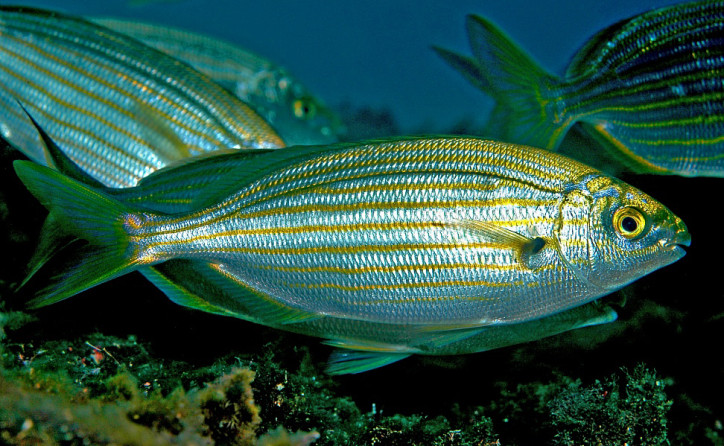Fish of the Sarpa genus of the Sparidae (sea breams and porgies) family of the superfamily Percoidea of the Percoidei suborder of the Perciformes order of the Acanthopterygii superorder.

(Salema. Photo © sepesca.com)
Salema (Sarpa salpa) was first described in 1758 by the Swedish naturalist Carl Linnaeus (1707-1778).
It inhabits the depth of 5-70 meters. It prefers to swim close to the rocky and sandy bottom, covered with aquatic vegetation. It is a schooling species. The maximum recorded length is 51 cm, specimens up to 30 cm long are more common. It feeds mainly on algae.

(Salema. Photo © portcrosparcnational.fr)
This fish became widely known after some articles had been published in the mid-2000s. The articles revealed the story about two visitors of the Mediterranean restaurant, who ate the meal made of Sarpa salpa flesh and had auditory and visual hallucinations, which began in 2 hours and lasted about 36 hours. It is considered that Sarpa salpa feeds on certain types of algae, which are digested and get into the tissues of the fish body. This may have the similar effect to the one described above.
It is a permanent inhabitant of the Adriatic Sea.
Names of salema (Sarpa salpa) in other languages as follows:
Salpa (Albanian), Салема (Salema) (Bulgarian), Gestreepte bokvis (Dutch), Σάλπα (Salpa) (Greek), Salpit (Hebrew), Salema (Spanish), Salpa (Italian), Goldstrieme (German), Salpa (Polish), Salema (Portuguese), Сальпа (Saljpa) (Russian), Saopa, Salpa (Serbian, Croatian, Slovenian), Çitari balığı (Turkish), Saupe (French), Očnatec obecný (Czech).